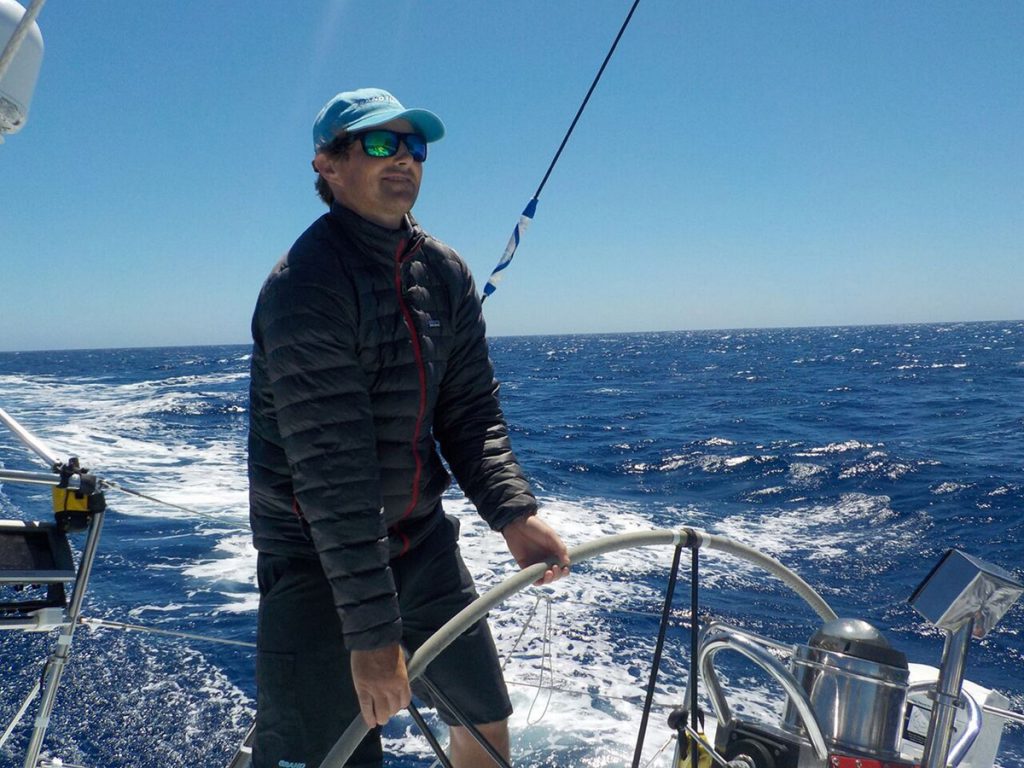
— Photo courtesy Brian Bissell ©
A local sailor participated in an epic ocean-crossing, stamina-testing, yacht race recently, that was at times, a bit perilous.
Brian Bissell joined the 50th running of the classic Transpacific Race. Boats left Rainbow Harbor in Long Beach on July 6. Bissell’s crew arrived at the Diamond Head finish line in Honolulu eight days later, earning fourth place.
There were a few nerves thinking about being at sea for that long of a time, but ultimately it was well worth the challenge.
“It exceeded my expectations on how much I would enjoy it,” Bissell said. “It was such an enjoyable journey, and a large part of that was the group of guys and the boat we were on, which was a fun boat to sail.”
Bissell is senior vice president, client advisor for Newport Beach-based Whittier Trust, an investment and wealth management company.
He and the crew sailed Grand Illusion, a Santa Cruz 70 yacht owned by David Clark, based out of the Newport Harbor Yacht Club. Bissel’s position with the crew was main trimmer.
He kept a log during his days aboard the boat while he crossed the ocean, writing about the weather and conditions, close calls, getting literally knocked off his feet once, the sinking of another boat in the race, his thoughts during the entire experience, the work, and more.
“It was very stream of consciousness,” Bissell explained in an interview recently.
His favorite part of the entire experience was the sense of accomplishment in getting everyone there safely.
“We accomplished an amazing feat,” Bissell said.
The team worked together great and sailed the boat really well, he added.
He’d “absolutely” do it again, but the circumstances would need to be right.
The group of people he sailed with this year and the type of boat they raced would be hard to beat, he said.
The Santa Cruz 70, nicknamed sled, is really good for surfing the ocean swells, Bissell explained.
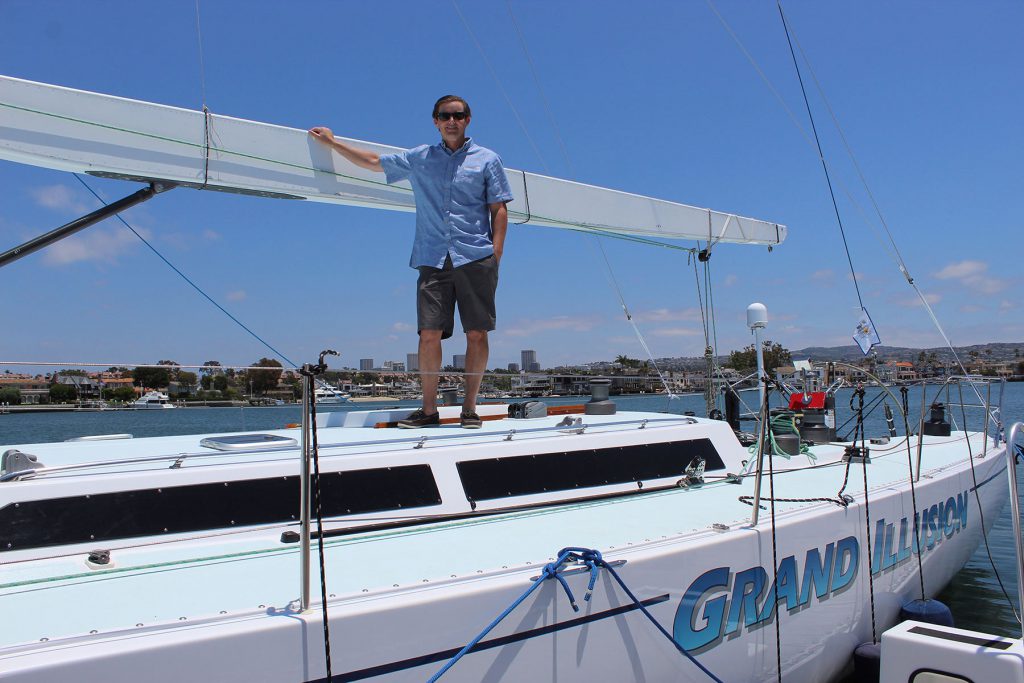
— Photo by Christopher Trela ©
“It was like a 70-foot longboard,” he added, “it catches waves really well.”
Transpac is one of the top three ocean races in the world, Bissell explained.
“It has a lot of tradition and notoriety,” he added.
Having grown up in Orange County and having this race in his back yard, the Transpac was always his Everest-equivalent.
This is something sailors train all their life to do, he explained, and finally being able to do it is a big accomplishment in of itself.
“I’m proud to be part of that tradition and the legacy of the Transpac,” Bissell said.
The biggest surprise was that the food was a lot better than he had imagined.
“On our boat, we ate really well,” Bissell said.
Most people think they have to pack really light, he explained, with small portions and rationing what they eat, most of which is freeze dried. Some people lose weight, he added.
“The camping population has upped their game on freeze dried,” he joked. “We probably gained a pound or two from eating so well.”
The whole meal plan was provided by the owner’s wife, Shelly Clark. Meals included teriyaki chicken or beef stew, Bissell noted.
It was “off the charts good” he wrote in his log one day.
The course the boat needed to steer was a “fine line,” Bissell explained.
“If it was a little too far right or left it could wipe out,” he said. “We really had to lock in on a few degrees on the compass.”
It takes a lot of strength to steer the boat as well, he added, particularly on windy days.
Because of the type of sail it is, “it’s really like a parachute,” Bissell commented.
“It can exert a lot of force,” he added.
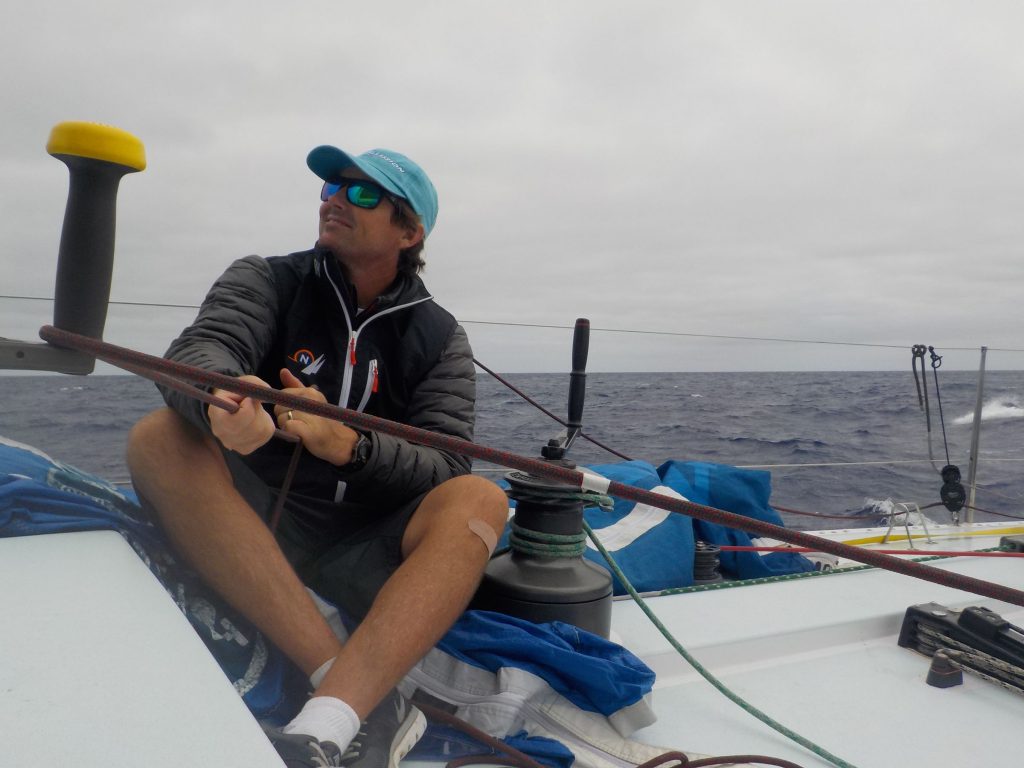
— Photo courtesy Brian Bissell ©
As the crew is trying to gather it, if it’s really windy and it hits the wrong way, it can be very dangerous, he explained. People could be knocked overboard.
“The load on those lines can really toss bodies around, so you need to make sure you’re not in the way,” Bissell said.
At one point, a sail did fill with air and the line jolted taut, knocking Bissell’s feet out from under him.
“I did a somersault,” he said. “It all happened so fast.”
On deck, the crew are hurrying from one spot to another, trying to work on the next part of the procedure they’re doing in the maneuver.
“I was standing in the wrong place, at the wrong time,” Bissell said. “It kind of goes to show that you really have to have your wits about you and pay attention all the time.”
He banged up his knee, but it could have been a lot worse, he added.
They finished around midnight and, after taking about an hour to get to the dock, a welcome party, including Bissell’s wife, Perry, greeted the sailors. A group assigned to their boat provided BBQ, traditional Hawaiian food, mai tais, and leis. It was a great finish line celebration, he said.
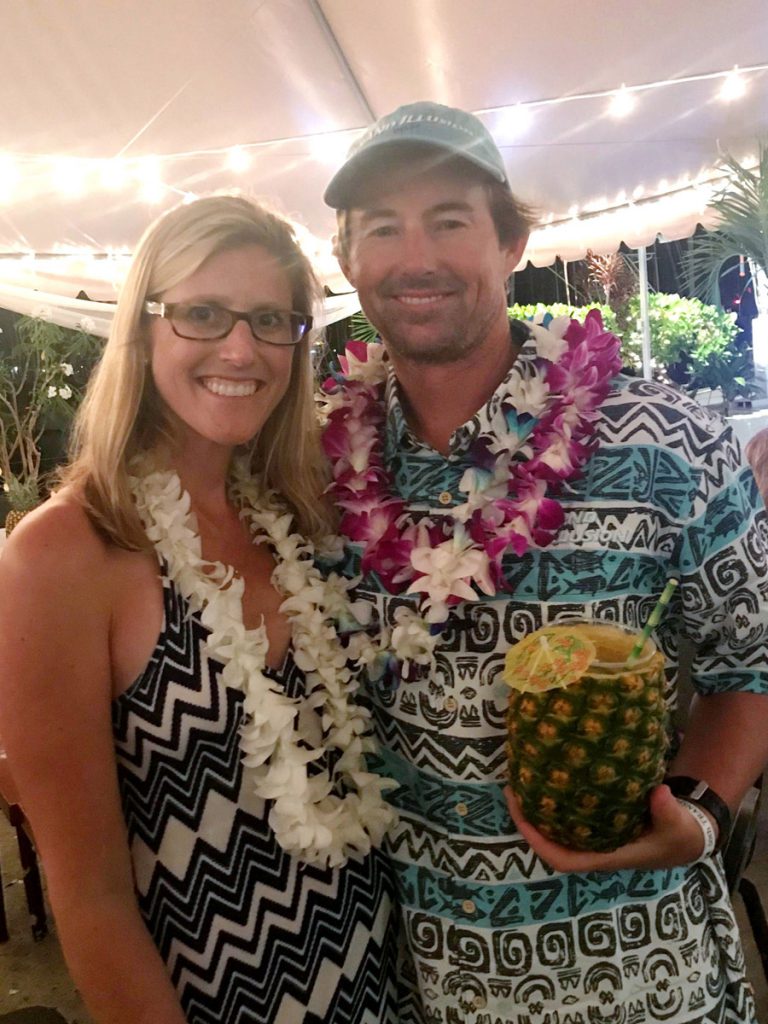
— Photo courtesy Brian Bissell ©
“We were expecting everyone to be asleep,” Bissell joked.
He flew home.
Whittier Trust, which was a heritage sponsor of the race this year, also has a long tradition and history with Transpac, Bissell pointed out.
Members of the Whittier founding family competed in the race in 1937, he said, and continued off and on over the following years.
“Whittier Trust was excited for me to participate as kind of extending that legacy,” Bissell said. “I’m grateful for the opportunity that Wittier Trust allowed me to participate.”
Bissell compared his crew’s Transpac race strategy to what the team is doing at Whittier Trust.
“(Sailing Transpac is) about being able to adapt to changing conditions, coming up with a plan… and watching ocean patterns and weather conditions,” Bissell explained. “You need to be able to adapt and evolve along the way.”
It’s not as easy as just charting a course from Los Angeles to Honolulu and taking the shortest course, he continued. It’s about catching the right waves and getting the most out of the wind. They might sail a longer distance to get over to a squall, he added.
“Whittier Trust is also about putting a plan in place,” Bissell said. “Wealth management, with the changing tax laws, daily dynamics, and changes in the market, it’s also about adapting and evolving.”
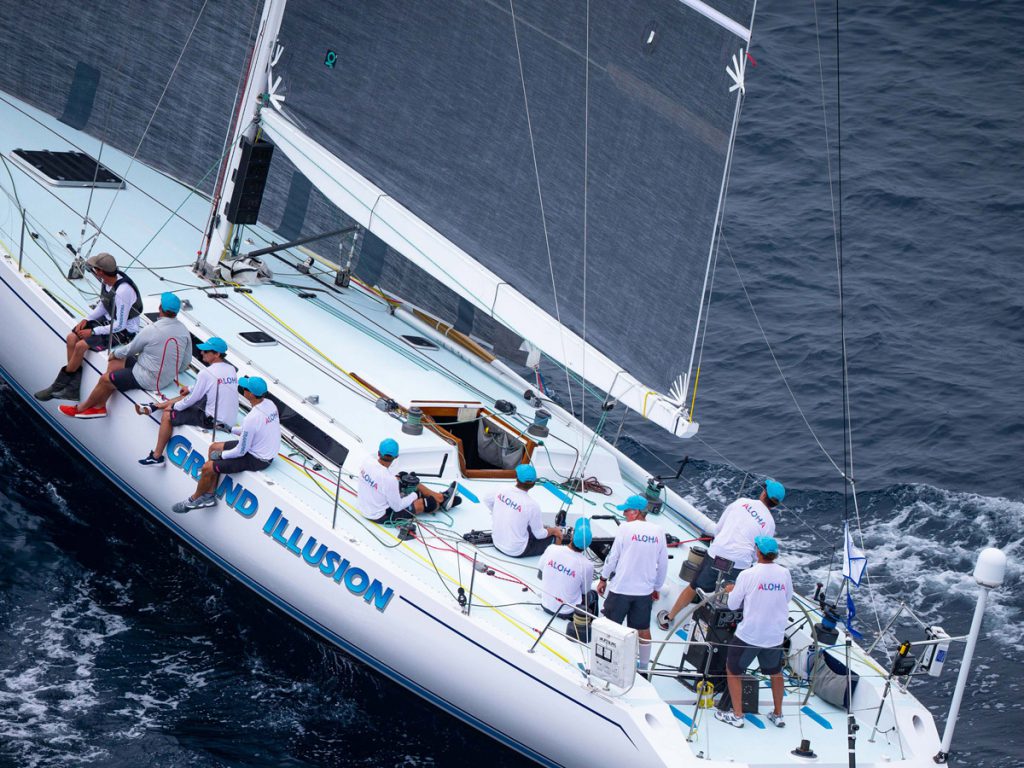
— Photo by Sharon Green ©
Continue reading below for a detailed summary of Brian Bissell’s Transpac log.
Brian Bissell 2019 Tanspac Log
He titled his first written log entry “Full speed ahead” and detailed the opening day of the race, which included an exciting start and a helicopter that flew a bit too close.
“Day one started with a bang! As the starting gun went off, we were hitting the line at full speed and in a great position on the line,” Bissell wrote. “We were able to hold our lane and keep our wind clean. Many of our competitors weren’t so lucky and had already put themselves well behind and in a catch-up position right off the bat.”
Adrenaline was pumping and the crew was extremely pleased with the start, he added. It was an overcast day, as were several other days out on the ocean during the race.
Bissell pointed out that Hundreds of spectator vessels and helicopters followed the competing boats miles.
“Our sails were even impacted by the air disturbance from one of the observer helicopters, it got so close,” he wrote in his log. “Once we got further offshore, the wind became unpredictable and light.”
They had to change to their drifter sail a few times, and the whole fleet was becalmed at different points in time, causing boats to separate by large distances, he wrote.
“We prefer to stay close to our competitors, so that luck would be less of a factor, but when the wind dies and fills in randomly the fleet inevitably spreads out,” he noted. “We wound up being one of the boats further south.”
During the second day, which he titled “Beware of artillery fire,” he wrote about a close encounter with a friendly competitor and some unexpected military activity.
He drove quite a bit during both of his shifts, 8 p.m. to midnight and 5 a.m. to 9 a.m., but the night shift was most difficult, he reported.
“We had the drifter up and it was hard to keep the sails full,” Bissell explained. “The morning shift was fun because we had a lot of close contact with Pyewacket. We passed them when they got stuck in a hole. Then they passed us when we got stuck in a hole… we passed them again and crossed so close they were able to ask us what’s for breakfast without having to raise their voices.”
Later, as they passed San Nicholas Island, the U.S. Navy got on the radio and instructed boats in their vicinity to head further south to steer clear of their live fire practice.
During his later shift, waves were strongly hitting both sides of Grand Illusion.
“It feels like a violent earthquake down below,” Bissell commented.
He concluded his entry saying he was nervous that they would get stuck in the high pressure system to the north.
Day three, titled “That sinking feeling,” was “an eventful evening in one of the worst possible ways.”
A Transpac competitor about 10 miles away, OEX, sank in the middle of the night. Pyewacket was only two miles from them and were able to get to them first.
“But by the time they arrived, the boat had sunk and the whole crew had jumped into life rafts,” Bissell explained.
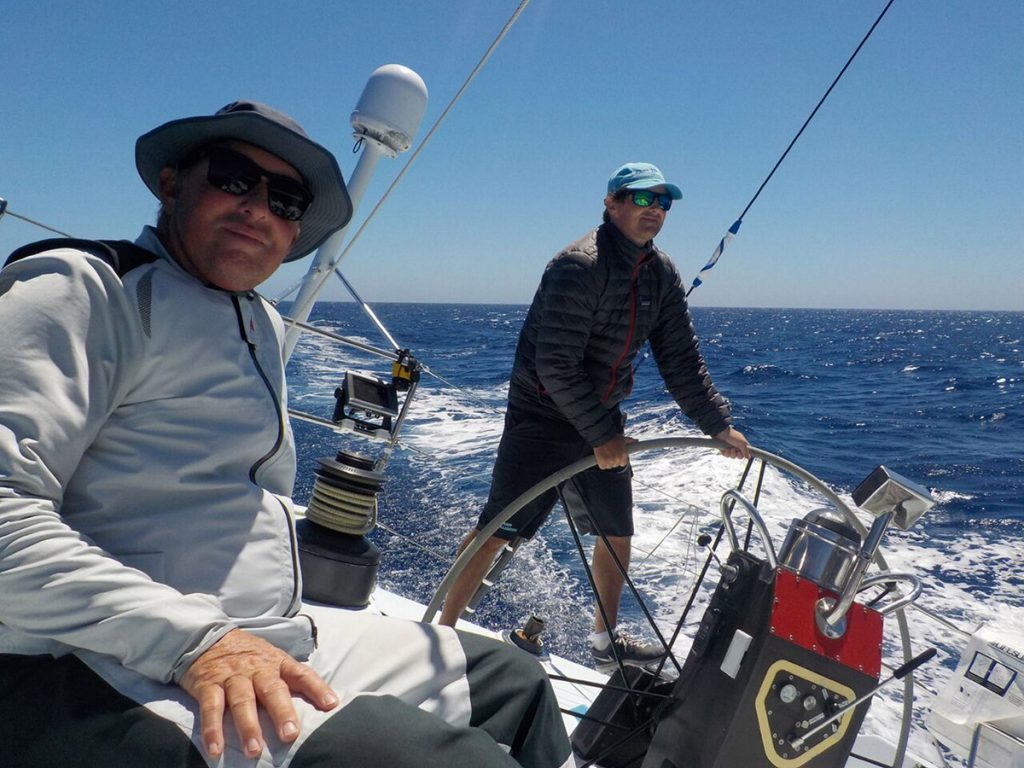
— Photo courtesy Brian Bissell ©
Pyewacket retired from the race and headed back to Los Angeles with the entire OEX crew onboard and safe.
“I feared the worst for the crew of OEX when we first heard their distress signal,” he wrote. “Not to mention that the unfortunate incident made me kind of nervous sleeping down below. It forced me to do something that should have been done weeks ago… planning my escape route just in case we were in the same situation. I wonder if that was the first boat to sink during a TransPac race?”
Later that day the sun finally came out and Bissell got the Grand Illusion up to 18.5 knots surfing down a wave.
During his evening shift, they put up a spinnaker for the first time. During the process, which took place in windy weather, a crew member dislocated his shoulder.
Day four, titled “20 plus knots and second place,” he hit 22 knots while steering the boat. He also wrote about a sail change that literally knocked him off his feet.
During his “off watch” time there was an all hands on deck call for a sail change. Bissell’s job was to grab the lazy spin sheet to retrieve it once the tack was spiked.
“When we started the process, the boat wasn’t sailing low enough and the spinnaker filled with wind,” he wrote. “The line went tight and completely lifted me off the deck and swept my feet out from under me. Only a scrape on the knee to show for it; a small reminder that you don’t mess with Mother Nature.”
His fifth entry was short and sweet, titled “Something about the sea.” He wrote about the great conditions, which created a fun day of sailing.
“We had sun, wind, clouds squalls with a little rain and a beautiful sunset. Did a couple peels that went very smoothly,” he wrote. “There is something about the sea that never fails to satisfy.”
On day six they crossed the halfway point of the race, but as Bissel pointed out in his log entry, “No halfway party,” there wasn’t much celebration on board the Grand Illusion.
He also noted that they’ve seen mini man-o-wars, flying fish, a huge school of tuna jumping out of the water, dolphins, birds, and one crew member saw a whale.
Day seven, log entry titled “A 70-foot longboard,” detailed the “coolest and gnarliest sailing.”
His 9 p.m. to 1 a.m. shift was dark with no moon and with dark squall clouds looming. The wind picked up to 26 knots as he was driving.
“The waves were huge, you couldn’t see anything,” Bissell wrote. “Had to drive purely by feel and instruments. Fun and scary. The waves hit the back of the boat and it felt like the boat wants to spin out one way or the other.”
He wrote that they were hoping the breeze was localized and the competition was getting the wind that they had.
“Feels like a 70-foot longboard,” he wrote.
Another crew member got frustrated driving in “finicky” conditions, so Bissell took over for a bit.
“I ended up driving for an hour and a half and handled the challenges of a wind that seemed to have a mind of its own,” he wrote in his log “I’m becoming more confident and satisfied with my driving.”
Day eight, “Gnarly driving and gratitude,” detailed when the spinnaker collapsed and twisted. Bissell and other crew members went up on deck to pull it down, while the wind was blowing about 25 knots. They wrangled it down into the forward hatch.
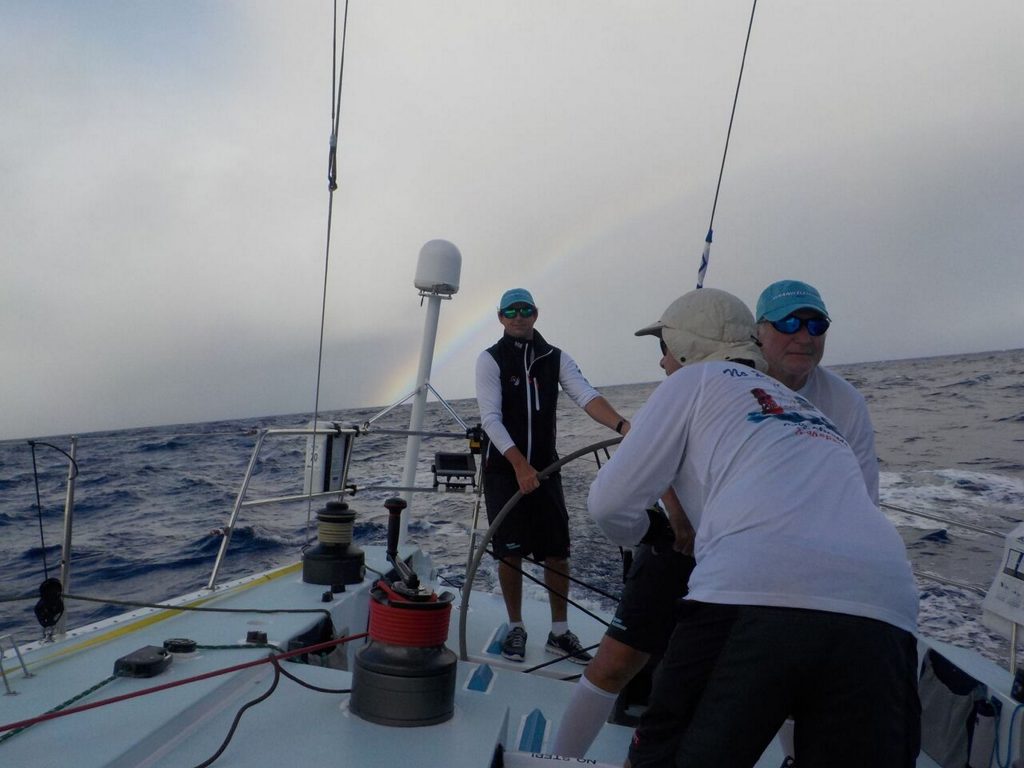
— Photo courtesy Brian Bissell ©
“At any point in time, if the wind had filled the spinnaker, we all probably would have been thrown overboard,” he wrote in the log.
He also mentioned seeing a moonbow and several rainbows. The stars never looked better, Bissell wrote.
“The crew has gotten past the usual adjustments of close quarter living and is having a lot of fun… appreciating the beauty and grateful for the experience,” Bissell commented in his log.
And in his final entry, “A close finish,” Bissell writes about their last push into Diamond Head.
Noting where he thought the other boats were, he wrote that they were hoping for a podium finish, but that it would be close. They finished in a very tight fourth place.
He’s tired, both mentally and physically, by this point and all his work shifts are starting to blend together.
“Exhausted but happy,” he concluded.
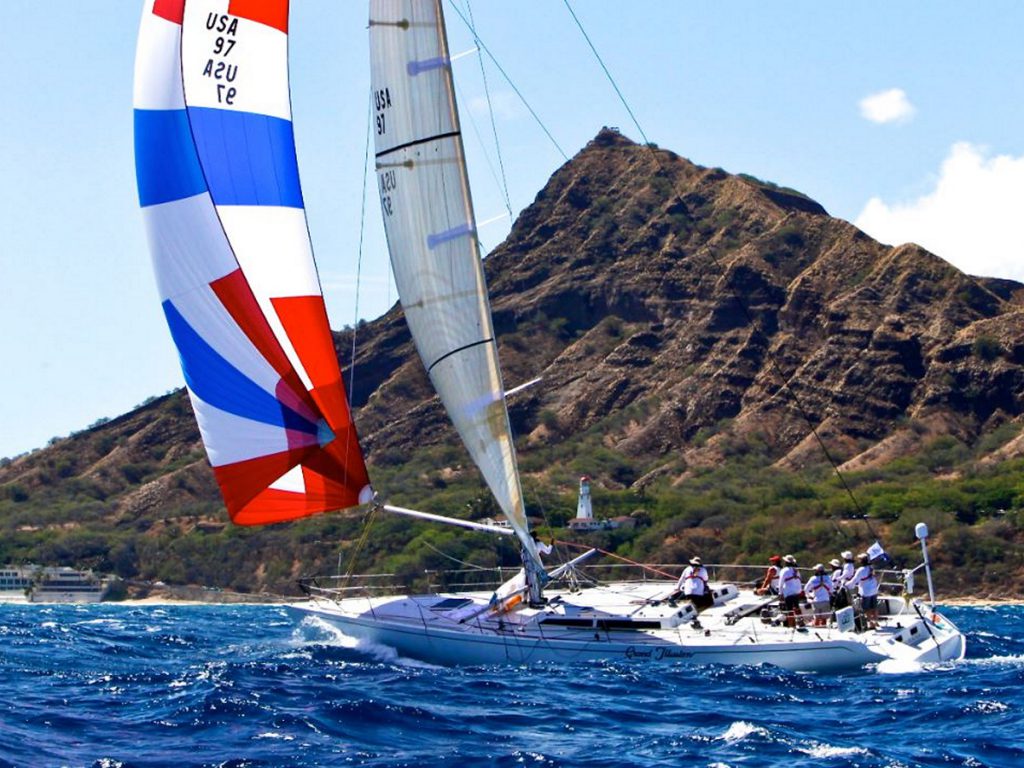
— submitted photo




